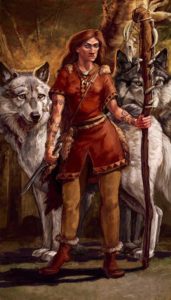 In the land of the Northern Europeans, the very first beings were the giants and giantesses. I call them the Jötunn folk for they come from the realm of Jötunheimr. One story that I find particularly fascinating is that of Angrboða and her three children. She is known as the Hag of Iron Wood, one of the witches of Iron Wood who are a group of giantesses that gave birth to fierce wolves. Angrboða took Loki as her consort, and as a product of that union, gave birth to Fenrir, Jormungandr, and Hela.
In the land of the Northern Europeans, the very first beings were the giants and giantesses. I call them the Jötunn folk for they come from the realm of Jötunheimr. One story that I find particularly fascinating is that of Angrboða and her three children. She is known as the Hag of Iron Wood, one of the witches of Iron Wood who are a group of giantesses that gave birth to fierce wolves. Angrboða took Loki as her consort, and as a product of that union, gave birth to Fenrir, Jormungandr, and Hela.
Angrboða was called Hag, but this comes to us in the same way as Hagia, meaning wise. She was the tribal wise woman of the Nine Clans of Iron Wood, often referred to as the chief of chieftains. The Iron Wood Clan were known to be werewolves – some staying in animal form, others shapeshifting at will to other forms, some were feathered and some scaled.
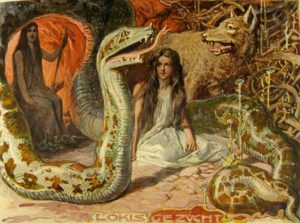 So it comes as no surprise that the children of Angrboða were a wolf, a serpent, and a woman, half-dead/ half-alive. Angrboða is a grief-giver. Her name means “foreboding” and she ultimately functions as the giantess who undoes creation or brings about destruction through each of her children.
So it comes as no surprise that the children of Angrboða were a wolf, a serpent, and a woman, half-dead/ half-alive. Angrboða is a grief-giver. Her name means “foreboding” and she ultimately functions as the giantess who undoes creation or brings about destruction through each of her children.
Angrboða reveals herself to us primarily as a mother figure through the stories of her children. She is however, much more. In her stories we can find all aspects of the Goddess in her.
In the time that these stories originated, marriage was not as we know it today. It is often thought that she was married to Loki but in fact, he was her consort. She is a perfect example of independence and our right to choose, her choice of a consort. She was a tribal wise woman referred to as chief of chieftains, her strength and wisdom honored by her people.
She chose to bring three children into the world and no more. Angrboða’s children give us a great opportunity to explore our own shadow nature – that which we hide in all its perceived ugliness. And Angrboða, as their mother, gives us a beautiful example of unconditional mother love, a mother loving her children in the darkest of ugliness.
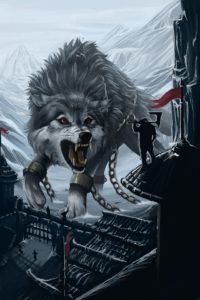 Fenrir is a terrible monster in the shape of a wolf. There was a story that one day, Fenrir would be responsible for the destruction of the world, and so they did everything in their power to destroy him before he could. After many attempts to chain him, with each chain being too weak to hold him, they appealed to the dwarves to create a chain that could contain him. And so they did. In the process of getting this chain on him, Fenrir bites Tyr’s hand off and ultimately consumes Odinn—the wise one.
Fenrir is a terrible monster in the shape of a wolf. There was a story that one day, Fenrir would be responsible for the destruction of the world, and so they did everything in their power to destroy him before he could. After many attempts to chain him, with each chain being too weak to hold him, they appealed to the dwarves to create a chain that could contain him. And so they did. In the process of getting this chain on him, Fenrir bites Tyr’s hand off and ultimately consumes Odinn—the wise one.
Fenrir serves as the raw, passionate power of women from which we may feel overwhelmed by or deny or suppress. When we read of Fenrir’s passion, his fierceness, and his raw power, we can look within our own lives for this, living in a patriarchal society in which so much of who we are is, or can be, suppressed. Through Fenrir the patriarchal-based Norse cosmology ends—Fenrir cannot ultimately be contained no matter how hard Odinn tries. This tells us that no matter how hard we try to suppress this power and passion, it is there and something we need to learn how to be comfortable with, for within it is a divine creative ability, meant for us to use.
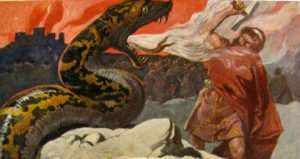 At one time, Jormungandar lived in Asgard, another realm of the Norse. He was cast out by Odinn and banished to the sea surrounding Midgard (the home of humans) and it was Odinn’s hope that he would be consumed in the waves. However, rather than be consumed, Jormungandar thrived and pretty soon all the fish had been eaten and the water levels fell so low that Jormungandar encircled the entire planet. He is the serpent that wraps around and contains Midgardr. Jormungandar holds the world together preventing disorder and chaos from ensuring, until Thor comes along and disrupts everything; the serpent rises and unleashes poison into the world and the world fragments.
At one time, Jormungandar lived in Asgard, another realm of the Norse. He was cast out by Odinn and banished to the sea surrounding Midgard (the home of humans) and it was Odinn’s hope that he would be consumed in the waves. However, rather than be consumed, Jormungandar thrived and pretty soon all the fish had been eaten and the water levels fell so low that Jormungandar encircled the entire planet. He is the serpent that wraps around and contains Midgardr. Jormungandar holds the world together preventing disorder and chaos from ensuring, until Thor comes along and disrupts everything; the serpent rises and unleashes poison into the world and the world fragments.
Again we see the ugliness of shadow and the suppression of the energy available for creative uses. In learning of his story we need to ask, “How do I feel that I hold things together in my life and for those around me? What would happen if I let go? What “poison” do I fear they have or might become unleashed if that were to happen?
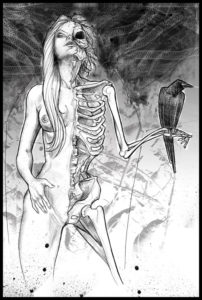 And lastly, we have Hela, who is the half-living/half-dead goddess. She was cast into the netherworld to care for those souls who did not die in battle. Her realm is called Helheim. She accepts all into her realm and is who decides what is to become of each soul who arrives. Helheim is a shelter rather than a “hell” as often portrayed by Christians. It is where souls gather until they reincarnate. As the keeper of the dead, she is always in a state between the light and the dark.
And lastly, we have Hela, who is the half-living/half-dead goddess. She was cast into the netherworld to care for those souls who did not die in battle. Her realm is called Helheim. She accepts all into her realm and is who decides what is to become of each soul who arrives. Helheim is a shelter rather than a “hell” as often portrayed by Christians. It is where souls gather until they reincarnate. As the keeper of the dead, she is always in a state between the light and the dark.
Many believe that our shadow nature is made up of those negative traits we wish to hide and not acknowledge. However, the other side of that, also a part of our shadow, are all of those brilliant things we could do – the talents and gifts that we have that we do not use. And so like Hela, we live between light and dark.
 We need to ask ourselves, what aspects of our lives that we carry around and are afraid to let go of are no longer breathing life into us? How do these aspects also give us power and discernment? What aspects of ourselves do we fear to develop or push aside for less important things?
We need to ask ourselves, what aspects of our lives that we carry around and are afraid to let go of are no longer breathing life into us? How do these aspects also give us power and discernment? What aspects of ourselves do we fear to develop or push aside for less important things?
These are all the parts of us. We are both light and dark. We would not be who we are without every aspect of our being. We wreak havoc in our lives when we suppress, ignore, stifle and shut down these aspects within us. As Angrboða, we must mother ourselves; give ourselves unconditional love, even in our ugliness, for in our ugliness, lies great power to create beauty in our lives and in the lives of others.
